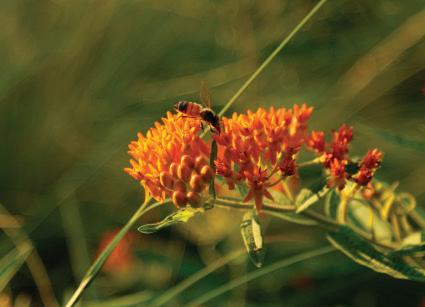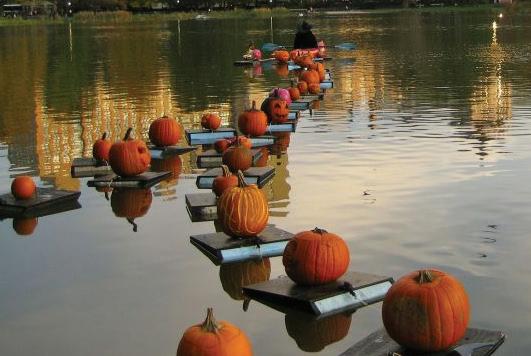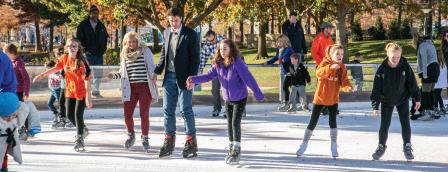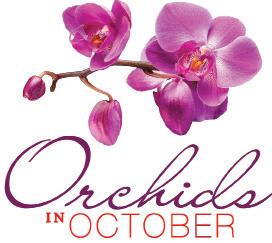
7 minute read
Horticulture Happenings
Horticulture Happenings By Casey Sharber, Director of Horticulture
It is said that a farmer has about 40 growing seasons in which they can do their best work. Meaning a farmer has 40 opportunities to improve their harvest from one year to the next. In our case here at Myriad Gardens, each year we learn something new and work to improve the Gardens to make the visitors’ experience even better.
This past year, we worked hard to achieve many lasting improvements in the gardens. Months of planning helped us achieve several project goals during a very limited and heavily scheduled time period – spring!
GREAT LAWN TREES
One of the first projects we undertook was to replace the 48 trees on the Great Lawn. Originally planted with Shantung hybrid maple trees that were suffering from a condition called Southwest injury, we replaced them with ‘Green Vase’ Zelkovas. Finding 48 large trees that looked similar in size was no easy feat and involved a nationwide search. After sourcing some larger ones in Georgia and some slightly smaller ones here locally we decided to go with the local ones, knowing that a local tree is more resistant to local conditions (weather, insects, disease, etc.) and that a slightly smaller tree would handle transplanting better than a larger tree. Tree anchoring systems were also purchased in advance in order to stabilize the newly planted trees without the imposing stakes and guy- wires that you often see on newly planted trees.
We are happy to report that all the trees are doing well and will continue to pro- vide more shade along the sidewalks and perimeter of the Great Lawn for years to come.
PRAIRIE GARDEN
Many of the plants for this garden were pre-ordered in 2014 and while often prairies are seeded when being established we wanted a more immediate impact and planted larger rooted plants. The grasses that were a bit easier to source were mainly in 1 gallon containers but went up to five gallon containers, while the wide array of herbaceous flowering perennials were mainly two inch plugs, quarts, or one gallon containers. There are pros and cons to a small plant verses a larger plant including cost and ease of planting, but the biggest factor is the watering and with such a mix of plant sizes it was even more critical to be cau- tious not to let the small plugs dry out in such a large planting bed. Fortunately for us, we got the prairie and pollinator garden planted the first week of May and it seemed to rain every few days after for the rest of the month.
We are very excited about this new garden and if you look at it now you would 5 never guess that some of those plants started out as plugs not much larger than your thumb. The butterflies do not seem to notice and seem to be loving their new home.
The Prairie Garden would not be possible without the generous support of the Kirkpatrick Family Fund and Stanley Smith Horticultural Trust.
GEO BEDS
After the installation of the Prairie and Pollinator Garden we wanted to improve the connection to the nearby Geo Beds located on the southeast corner of the gardens by showing how to incorporate many of the same native pollinator plants into a more designed landscape. Using the existing plants and adding more natives and pollinator plants, these beds were redesigned to improve the garden displays. The design took in to account the bloomtime, plant size, sun exposure, water requirements, flower and foliage color, and textures of the plants.
We encourage you to stroll through these gardens and identify your favorite plant combinations and which ones you might like to try in your own garden.
MEINDERS GARDEN
Part of designing a garden is adding layers of plants to make it more intriguing. This is what took place in the Meinders this past spring as we added another layer of native plants into the mix. The areas we specifically focused on were around the rill just east of the north plaza, the beds just west of the large boulder fountain on the corners and street side planting along Ron Norrick between the fountain and the Ice House.
This area has always been a special place in the garden as it is more intimate, cooling, and calming. The birds love the new plantings as you can watch them take dust baths and splash in the rill. It is a true oasis for nature and people.
Saccharum ravannae, Ravenna Grass

Asclepias tuberosa, Butterfly Weed. Photo by Doug Hoke.
CHILDREN’S POLLINATOR GARDEN
The Children’s Garden is the perfect place to begin educating youth about the importance and relevance of plants in our daily lives, so this spring we planted a Pollinator Garden showcasing over 40 different plant species. Plants were chosen for their attractiveness to pollinators like bees, butterflies and moths, as well as for their performance in Oklahoma gardens. We included plants like coneflowers, verbena, milkweed, and blanket flower and, this summer, the garden was bursting with color and insect activity. The educational programs that can come from having a garden like this are endless and this past summer children were buzzing about pollination!
GARDENS WALKING TOUR Last Saturday of Every Month, 10am October 31, November 28 and December 26 South Lobby and Garden Grounds FREE / Walkups Welcome
Join us for our Myriad Gardens Walking Tour program! The tours, “Plants for Color” or “Plants for Water Conservation,” highlight plants in each season around the Gardens. Enjoy guided tours at 10am the last Saturday of each month or pick up a self-guided tour handout in our south lobby.
Thank you to the Oklahoma City Community Foundation’s Parks & Public Space Initiative for making this possible!
Kids & Families
BRINGING BOOKS TO LIFE
Every Wednesday in October 10 – 11am Crystal Bridge South Lobby FREE Best for ages 2-5
Bring your youngster for story time each Wednesday at 10am. Books are nature-themed and selected based on the season. Children will also enjoy creating a small craft after the story.
CIRCUS NOUVEAU AT BOATHOUSE
Friday, October 2, 7pm OKC Boathouse District, Sky Trail All Ages; FREE Sponsored by
The Gardens has teamed up with the Oklahoma City Boathouse District to help kick off the Oklahoma Regatta Festival. Art that enchants, invigorates and awakens the imagination has always been born of the rule breakers, and no one is breaking the rules more joyously, more fervently than Quixotic. Performing on the Sandridge Sky Trail, Quixotic will deliver a completely unique aerial performance for Oklahoma, complementing the innovation and upward momentum of Oklahoma City’s iconic Boathouse District and Myriad Gardens.
Pumpkinville Events (see pages 3-4)
October 9-25, 10am – 5pm PUMPKINVILLE PRESENTED BY OGE ENERGY CORP.
Saturday, October 10, 11am – Noon TRULY TASTY PUMPKINS
Friday, October 9, 16 and 23, 1 – 1:30pm CIDER PRESS DEMONSTRATION AND TASTING
Saturday, October 10, 11am – 2pm PAINTING IN THE GARDENS SERIES WITH WINE AND PALETTE
Saturday, October 10, 17, and 24, 1 – 1:30pm STORY TIME AT THE PUMPKINVILLE LIBRARY
Saturday, October 24, 1 – 2pm WHY DO LEAVES CHANGE COLORS?
Saturday, October 24, 6 – 8pm
PUMPKINVILLE HALLOWEEN PARTY: GARDEN MONSTER BASH SPOOKY POOCH PARADE
Friday, October 16, 6:30pm $10 per dog Pre-registration preferred for dogs Walk-up’s welcome if not sold out Great Lawn Sponsored by

Join us for our inaugural Spooky Pooch Parade on the Great Lawn. Enjoy spooky music and our parade of pooches. Judges will present prizes to the best dressed pooch!

GREAT PUMPKIN FLOAT
Friday, October 16, 8pm Must pre-register- $5 suggested donation per entry Lower Lake All ages welcome
Join us for the first ever Great Pumpkin Float, which sets sail across the Crystal Bridge Lake at twilight!
Due to the limited number of floats and space, pre-carved pumpkins will only be accepted at the designated drop off locations between 3:30 and 5:15 pm or until the float reaches capacity. Members: pre-register before October 12 to secure your pumpkin’s spot on the float!
Great Pumpkin Float Guidelines:
• Pumpkins must be pre-carved with top • Weight: approximately 8 pounds after carved; mini pumpkins will not be accepted • Size: No bigger than the size of a soccer ball • Decoration: No artificial materials, such as paint, glitter, marker, food dye, paper or plastic. This is to protect the ecological health of our lake should your pumpkin decide to go for a swim!






